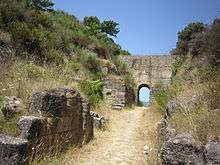Polygonal masonry
Polygonal masonry is a technique of stone construction . True polygonal masonry is a technique wherein the visible surfaces of the stones are dressed with straight sides or joints, giving the block the appearance of a polygon.[1]
This technique is found throughout the world and sometimes corresponds to the less technical category of Cyclopean masonry.[2]
Armenia
Bosnia
China
the submerged city of Shicheng in Qiandao Lake
Chile
Ecuador
Baños del Inca
La Maná,
Finland
Hungary
Komárom Fortresses
Italy
In Italy it is particularly indicative of the region of Latium, but it occurs also in Etruria, Lucania, Samnium, and Umbria; scholars including Giuseppe Lugli have carried out studies of the technique.[3][4] Some notable sites that have fortification walls built in this technique include Norba, Signia, Alatri, Boiano, Circeo, Cosa, Alba Fucens, Palestrina, and Terracina.[5]

The so-called Porta Rosa of the ancient city of Velia employs a variant of the technique known as Lesbian masonry.[1]

Alatri Ruins, Italy
Japan
Latvia
Daugavpils Star Fort
Mexico
Morocco
Peru
Russia
Chusovoye Megalithic Wall, Russia
Spain
Sweden
Syria
Thailand
Turkey
United Kindom
References
- 1 2 G.R.H. Wright (23 November 2009). Ancient Building Technology, Volume 3: Construction (2 Vols). BRILL. pp. 154–. ISBN 90-04-17745-0.
- ↑ Carmelo G. Malacrino (2010). Constructing the Ancient World: Architectural Techniques of the Greeks and Romans. Getty Publications. pp. 97–. ISBN 978-1-60606-016-2.
- ↑ Frank, T. 1924. "Roman buildings of the Republic: an attempt to date them from their materials." MAAR 3.
- ↑ Giuseppe Lugli (1957). La Tecnica Edilizia Romana Con Particolare Riguardo a Roma E Lazio: Testo. 1. Johnson Reprint.
- ↑ Jeffrey Alan Becker (2007). The Building Blocks of Empire: Civic Architecture, Central Italy, and the Roman Middle Republic. ProQuest. pp. 109–. ISBN 978-0-549-55847-7.
- P. Gros. 1996. L'architecture romaine: du début du IIIe siècle av. J.-C. à la fin du Haut-Empire. 2 v. Paris: Picard.